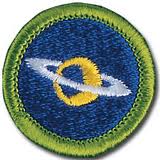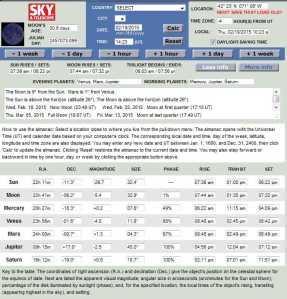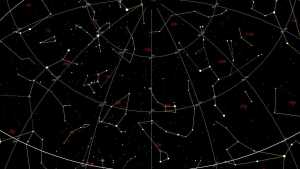Almost Done
Posted: March 31, 2017 Filed under: Astronomy | Tags: astronomy merit badge, Constellation, Scout, Zodiac Leave a commentOur second and final meeting at the Boy Scout Merit Badge College is coming up this Saturday. We’ve had some great nights for stargazing (and a few not so good nights) so I hope you’ve been practicing.
This week you should check all of the work you’ve completed. Make sure your name is on every page, all requirements are numbered and try to put them in order. I’ll try to get through everyone’s materials and get them back to you as soon as I can.
When we meet, I’ll take everyone into the dome one more time and go over all of the stars and constellations. After that we’ll go back out to the table where you can finish up any requirements you need a little more information for. I’ll have my collection of Astronomy and space books, if there’s something you just haven’t been able to find. While people are getting things together,
I’ll be taking two Scouts at a time back into the dome for the star and constellation test. One Scout will get the pointer and identify 10 constellations (four from the Zodiac) and 8 stars. The other will stay in the entry tube to get dark adapted. After the first Scout has identified his stars and constellations ( or given up ), he’ll leave the dome and another Scout will come into the entry tube to get dark adapted while the Scout who was in the tube takes his test.
My wife will be there to help anyone who needs a little assistance. She’s a Girl Scout Astronomy Trainer so she can answer most of the questions you might come up with.
If you don’t finish all of the requirements now, you’ll be able to send them along to me as you complete them. This is a fairly difficult badge to earn and our time together is fairly short, but most of the requirements are things you can do on your own. Don’t give up. I’m always just an email away when you have a question.
If you don’t pass the constellation and star test, things get a little complicated. We won’t have a space to set up my dome when the college is not in session, so you’ll have to take the test under the real sky or wait until next year and finish the test at the 2018 college. If you want to take the test under the real sky, remember the stars change every season, so the constellations and stars you see in May won’t be the same ones we worked on in March.
Mike
The Wandering Stars
Posted: March 30, 2017 Filed under: Astronomy | Tags: almanac, astronomy merit badge, planet visibility Leave a commentDeciding if a planet is visible or not in the evening (5b) seems to be a problem sometimes. There are a couple of ways to do this. One is to go to the library or pick up your own copy of the Old Farmers Almanac. Another is to use Stellarium and advance time a month at a time. A third ways is to use the Sky & Telescope Almanac.
Let’s think about what you need to know to decide. If you’re using the Sky & Telescope almanac (you need to register for the website to use this) to determine which planets are visible, they provide the information, but you need to do some thinking. The first thing that’s important is what time does the Sun set. The Sun sets at different times all year long and the last column on the first row of the almanac shows when the Sun sets. If a planet sets before or just after the Sun sets, you won’t be able to see it.
Look in the sixth column and you’ll see Mercury sets at around 8:00 pm so you’ll see it in the evening. Venus sets around 5:30 pm. You won’t see it in the evening right now. What about in the morning?
That method will work for most planets, but you’ll need to think a little harder for some of the others. Let’s look at Mars. It sets at around 9:00 pm. That one is easy, 9:00 pm is definitely in the evening, Mars is visible. Jupiter rises now at around 6:45 pm and doesn’t set until after 6:00 am, it’s visible all night. Saturn doesn’t rise until after 12:00 am and it sets in the middle of the morning. Now 12:00 am is the late for me, so that puts Saturn in the sky only in the morning.
I’ve just done the month of March for you. Now you need to start the Almanac (remember to check Daylight Savings Time), advance the +1Week button a couple of times to see what’s up in April. Advance again for each month and fill in your table (you are making a table aren’t you?) and you’ll know when you can see the planets all year long.
Mike Francis
Star Hopping
Posted: March 29, 2017 Filed under: Astronomy | Tags: constellations, Merit Badge, star hopping, stars Leave a commentToday I want to remind you of what we did at our first class, star hopping. If you create a path in the sky from one constellation to the next, it’s a lot easier to learn all of the stars and constellations. Let’s start in the North with Ursa Major. You should be able to find it by now as soon as you look into the northern sky. Once you find the bear, pick out the part of the bear that looks like a big dipper. The two stars at the front of the dipper are Dubhe on the left and Merak on the right. Draw an imaginary line through the two stars heading north. After you’ve gone 5X the distance between Dubhe and Merak you should run into a star that will be due North. That’s Polaris or the North Star. Hanging off the North Star will be another dipper, smaller than the first one and that’s Ursa Minor or the Little Dipper.
Extend the line from Ursa Major to the North Star that same distance and you should find a big W or M. That’s Cassiopeia, the queen of the night sky. It actually looks a little like a chair or throne. Once you imagine the queen, look where she’s looking and you should see a large group of stars that look like a house. That’s the head and crown of the Cephus the King, who actually looks a lot like a block headed clown. Now you’ve found all of the easy constellations in the Northern sky.
Turn around and face South. The first thing you should see will be the three stars that make up the belt of Orion the Hunter. Above the belt are two very bright stars that look like they could be shoulders. Betelgeuse is on the left and Bellatrix is on the right. Above the shoulders are three rather faint stars right where Orion’s head should be. Below the belt are three bright stars that could be a sword and below those are two more very bright stars that would be his legs. Saiph is on the left and Rigel is on the right.
Imagine a line through Orion’s belt heading West and follow it until you run into a letter V, that’s the face of Taurus the Bull. Look up to where the bull’s horn should end and you’ll find a big pentagon of stars, that’s Auriga the Herdsman. He doesn’t look much like a shepherd, but if you find the brightest of the five stars, imagine that’s his goat with her three babies nearby. She’s a singing goat, but she doesn’t have a band so she sings “a cappella” and what is her name? Cappella.
If you were drawing a circle in the sky from Orion to Taurus to Auriga and kept going you would run into two very bright stars that look almost alike. That’s the twin brothers Pollux and Castor. The stick figures of their bodies are right between the brother stars and Auriga. Remember what the boys are doing? Walking the dogs. Follow Pollux’s arm to two more stars, one bright, one dim. That’s the little dog, Canis Minor and the brighter star is Procyon. If you have a little dog keep going down toward the horizon until you run into a very bright star, Sirius the Dog Star which is the eye of Canis Major. Want to make sure you’re in the right constellation, look at Orion’s belt and go the opposite way you went to find Taurus.
To find the next few constellations, look back up at Ursa Major. Follow the arc of the bear’s tail until you run into another bright star, Arcturus. Remember arc to Arcturus. That’s the star at the bottom of another shepherd Bootes, but I like to think of it as Bootes the Kite with the four stars that make up the long and short pieces of a kite. Keep on going past Arcturus until you run into another very bright star, Spica. So if you arc to Arcturus you can just speed on to Spica. Spica is a the end of the tail of a great big letter Y that will be rising up into the South.
Back to Ursa Major and Dubhe and Merak. Follow them the opposite way that you went to find the North Star and you’ll run into a great big backwards question mark. Nearby it to the East is a triangle and when you put the two figures together it looks just like a lion, Leo the Lion. Right in front of the lion’s head will be Jupiter, the brightest dot in the sky and Jupiter is sitting right in the middle of the constellation Cancer. If you’re wondering if you’re in the right place, Cancer is right between Leo and the Gemini.
If you can work you way through all of those steps, you’ve found more than enough constellations and stars to pass requirement 4 a & b. Practice doing this for the rest of the week on clear nights and you should have no trouble Saturday.
Mike
http://www.Mike-Francis.com/sst.htm
Watching the Big Dipper
Posted: March 24, 2017 Filed under: Astronomy, Uncategorized | Tags: Big Dipper, Observation, Ursa Major Leave a commentIf you’ve been playing with your computer planetarium and looking at the stars at night, you should be starting to know some constellations and stars. Since it’s the weekend and you may be able to stay up a little later, this will be a good time to take a closer look at Ursa Major, the Great Sky Bear.
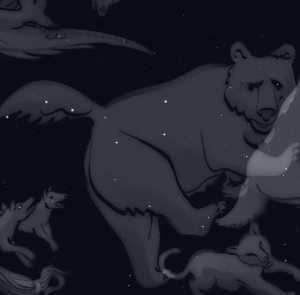 As soon as it gets good and dark (around 7:30 pm), head on outside and look for Ursa Major, the Big Dipper. (Check it out on your computer first to remind you what to look for) You should be facing North. Can you find the four stars that make up the bowl of the dipper? Can you see the three or four stars that make up the dipper’s handle? Make a sketch of the Big Dipper. You should include North marked on your sketch. Draw in any objects you see in the foreground like houses, trees, etc. and leave lots of room for the sky. Now add the Big Dipper and the time of your observation right next to it. Be very accurate, you’re going to need a good sketch to compare to later. Now look for your other constellations and stars or you can go back in or do what ever else you had planned for the evening.
As soon as it gets good and dark (around 7:30 pm), head on outside and look for Ursa Major, the Big Dipper. (Check it out on your computer first to remind you what to look for) You should be facing North. Can you find the four stars that make up the bowl of the dipper? Can you see the three or four stars that make up the dipper’s handle? Make a sketch of the Big Dipper. You should include North marked on your sketch. Draw in any objects you see in the foreground like houses, trees, etc. and leave lots of room for the sky. Now add the Big Dipper and the time of your observation right next to it. Be very accurate, you’re going to need a good sketch to compare to later. Now look for your other constellations and stars or you can go back in or do what ever else you had planned for the evening.
In a about 3 hours head back on outside (this is why a weekend night is a good one to do this, if this week doesn’t work out you can try again next Friday). Where’s the Big Dipper now? Does it look any different? Why? Add it to your sketch and label the time. That takes care of req. 4c.
Good observing.
Mike
Stars Science Theater
http://www.mike-francis.com/sst.htm
A few more constellations
Posted: March 23, 2017 Filed under: Astronomy, Organizations | Tags: Andromeda, Aries, Astonomy merit badge, Perseus Leave a comment
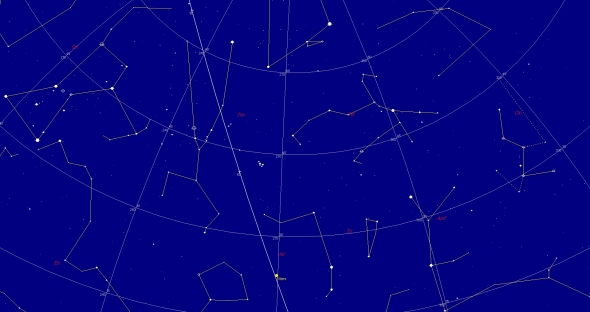 A last few constellations (click picture for larger view)
A last few constellations (click picture for larger view)
If it’s clear at night there are a few more constellations you can try to find. Aries is not very impressive to look at but if you’ve figured out how to find Taurus, look for two somewhat bright stars together in the sky about half way from the bull’s head and the horizon at around 8:00 pm. Mars is just below Aries right now, so use it to help find the constellation.
A little further to the right (North) and a little higher in the sky are three stars that make up a very nice triangle. The name of that constellation is Triangulum, how appropriate is that. Keep looking a little further to the North and you may just make out the great big letter V that is the Princess Andromeda. If you can find Andromeda, see if you can find the Andromeda Galaxy from where your live. Start at the point of the V right on the horizon and find the second star on the left branch, go straight across to the star on the right branch, continue on the same distance and look for a fuzzy blob of light, about the same size as the Full Moon. That is the billions of stars that are the Andromeda Galaxy.
A little further North and a little higher in the sky and you’re back to Cassiopeia. Right between Cassiopeia and Taurus lies Perseus. Perseus looks a little like a couple of fish hooks, stuck together. Further North from Cassiopia and you’re at Ursa Minor and just a little further to the East is Ursa Major and your back to where we started.
On clear nights be sure to go out and practice your stars and constellations under the real sky and on cloudy ones fire up Stellarium.
Leave a reply below to let me know how things are going.
Mike
Stars Science Theater
http://www.Mike-Francis.com/sst.htm
The Winter Circle
Posted: March 22, 2017 Filed under: Astronomy, Uncategorized | Tags: Auriga, Canis Major, Canis Minor, Gemini, Orion, Tarus, winter circle Leave a commentLets look for some more constellations and stars. When you go out tonight try to find some of the Winter constellations. Start by finding Orion. It should be just about a little west of due South at around 8:00 (turn around after you finished finding the North Star). You should see the three stars in a row that mark Orion’s belt. If you find the belt, the two stars that make up his shoulders should be just above and the three stars that are his head will be a little above that. Hanging from Orion’s belt is a sword, another three stars going down this time. Below the sword there will be two more very bright stars that mark Orion’s legs. The star that marks Orion’s shoulder on the East is Betelgeuse, the one on the West is Bellatrix. The leg below Betelgeuse is Saiph, the leg below Bellatrix is Rigel. Take a close look at Betelgeuse. If you’ve got them use binoculars. What color is it? Look at Rigel. What color is it?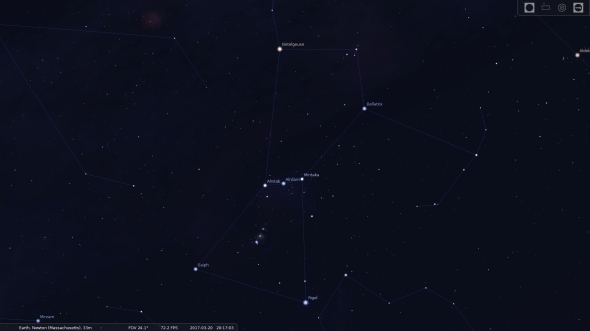
Look at Orion’s belt. Use his belt as pointers and look to the West. You should see what looks like a letter V. That V reminded the folks who gave the constellations their names of the smiling face on a bull when he’s getting ready to charge. The brighter star at the top of the V on the left is Aldebaran. Now look a little further to the West (right) and see if you can find the little cluster of stars that make up the asterism called the Pleiades. That marks the shoulder of the bull.
Back to Orion again. We followed the three stars of Orion’s belt to the West to find Taurus. Go the other way, about the same distance and you’ll see a very bright star. That’s Sirius. How does it compare in brightness to Jupiter high up above it? Sirius is the Dog Star so it must be part of the Big Dog or as astronomers like to call it, Canis Major. If you look carefully you should be able to make out the dog’s nose, back, front and back legs and it’s droopy tail.
Where there’s a Big Dog there must be a Little Dog, so look higher in the sky until you find two fairly bright stars all by themselves. The brighter of the two is Procyon. Don’t be fooled by going too far and finding the Gemini brothers. If you’re not sure which is which, the brothers should have stick figure bodies, the dog is just two stars. Another way to find the Little Dog is to first find the Gemini and then go from Pollux’s head to his arm and on to Canis Minor.
The next constellation to try to find should be almost directly over your head. There will be five fairly bright stars that make up a pentagon (five sided figure). That’s Auriga the Shepard. The very bright star at the top of the constellation is Capella the mother goat and if you look very closely you should see her three kids right beside her.
A little above Orion and just to the East there will be two stars that look almost alike. Those are the Gemini brothers, Pollux and Castor. Pollux is on the East, Castor is on the West. See if you can find the stick figures that make up their bodies.
We’re up to 12 constellations now and 12 bright stars. If you can find all of those in the night sky, you’ve learned more than enough to pass the test. If you’re still having trouble, practice on Stellarium and I’ll explain how to find a few more constellations in a future blog.
Mike
Stars Science Theater
http://www.mike-francis.com/sst.htm
Mike Francis Stars Science Theater
Circum Polar Constellations
Posted: March 20, 2017 Filed under: Astronomy, Uncategorized | Tags: Big Dipper, Cassiopia, Cephus, Jupiter, Merit Badge, Moon, Ursa Major, Ursa Minor Leave a commentLet’s hope we get a clear night. Before 7:30 pm Mars should be visible in the West, if you don’t have trees in the way. If you can’t see it, try to find a place to look at the sky that has a clear view of the horizon. You may also be able to see Mercury and Venus very low on the horizon if there aren’t trees in the way. If you haven’t looked for it planets yet, get out there on our next clear night.
As soon as it gets good and dark look for Ursa Major, the Big Dipper. You should be looking into the North. Look for the four stars that make up the bowl of the dipper? Can you see the three or four stars that make up the dipper’s handle? The two stars at the front of the dipper are Dubhe (on your left) and Merak (on your right).
Now that you’ve found Ursa Major you can look for the other circum polar constellations. To find Ursa Minor (the Little Dipper) use the pointer stars Dubhe and Merak, draw an imaginary line between them and continue it 5 times further towards the North. See a star there? That’s Polaris, the North Star. It’s right at the end of the Little Dipper’s handle or the little bear’s tail. Can you see the handle and the four stars that make up the bowl?
Keep your line going West about the same distance as the line from Ursa Major to Ursa Minor. Find the big W? That’s Cassiopia’s throne. If you find Cassiopia the Queen, King Cephus must be close by. Imagine the Queen sitting on her throne looking at the nearby stars to the right and you’ll see the four stars for Cephus’s head and the hat that looks like a clown hat.
Want to try another? Look right below Ursa Minor and see if you can find the head of Draco the dragon. It should be right on the horizon, so trees may make it impossible to find where you are. Do you see the dragon’s body? Good luck.
If you can find all five constellations, you’re half way to the number of constellations you need to learn.Every night when you go out, you should try to re-find these constellations and stars, so it becomes second nature.
Mike
Stars Science Theater
http://www.Mike-Francis.com/sst.htm
Welcome to Astronomy Merit Badge 2017
Posted: March 17, 2017 Filed under: Astronomy Leave a commentWelcome Scouts to the 2017 session of Astronomy Merit Badge for the Knox Trail Merit Badge College. I think we’re going to have a lot of fun and hopefully you’ll learn a few things in the process. This is not an easy merit badge to earn. There are a lot of things you need to do and a lot of things to learn, but if you are prepared you should have no problem accomplishing all of the requirements.
Here’s a little information about me. I am an actor and educator. You may have met me before when I brought one of my science programs to your school. I visit schools as Galileo, the Stargazer’s Apprentice and with my Starlab traveling planetarium (where we will spend most of our time). Before beginning my school programs, I was a lecturer for ten years at the Charles Hayden Planetarium at the Museum of Science in Boston. You can learn more about me by visiting my web site at http://www.Mike-Francis.com/sst.htm.
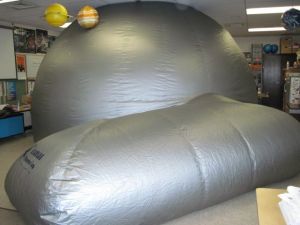
- A tight squeeze for the Starlab.
I hope you’ve started working on the requirements in your Boy Scout Merit Badge pamphlet already, so you don’t have to try to do everything all at once.
Learning the constellations and stars is always the hardest part. It’s a good idea to start looking at the stars on your computer, using planetarium software. If you have your own, you can start right away. If you don’t, I recommend a program called Stellarium hppt://www.Stellarium.org . It is free and comes in Windows, Mac and Linux versions. I’ve checked it out to make sure there is no spyware. Download it (with your parents permission, of course) and try it out. I’ll be posting a new message soon with some hints on how to use it. You can also try using one of the many astronomy apps for Androids and iPhones to get used to finding the stars in the real night sky.
At our second session (April 1st) I will be collecting all of your prepared materials that you didn’t finish by our first session. I expect to see well written answers and explanations and clearly labeled diagrams and sketches. We also spend our second session testing your knowledge of the stars and constellations.
I’m going to try to post something new to this blog daily. It may be something that will be helpful for earning your merit badge or it may be something that’s just interesting about Astronomy. I hope you can check in often. You can also send me any questions or make comments. If it’s clear outside at night, go out and look at the sky every night and practice finding constellations and stars.
Mike Francis
http://www.Mike-Francis.com/sst.htm
https://www.facebook.com/StarsScienceTheater
